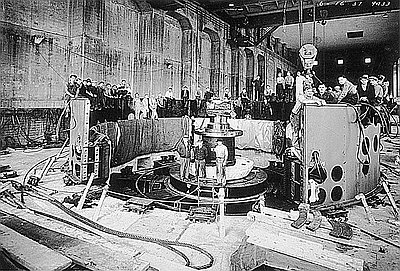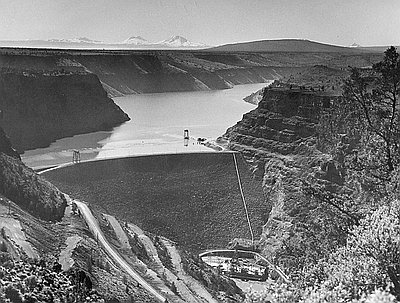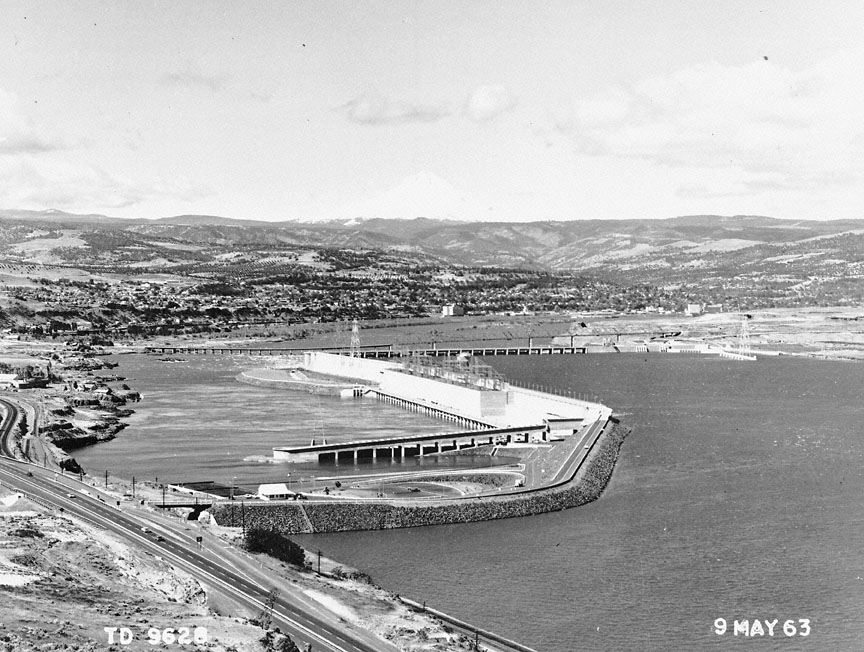- Catalog No. —
- CN 019498
- Date —
- May 9, 1963
- Era —
- 1950-1980 (New Economy, Civil Rights, and Environmentalism)
- Themes —
- Environment and Natural Resources, Government, Law, and Politics, Native Americans, Science, Medicine, and Technology, Trade, Business, Industry, and the Economy, Transportation and Communication
- Credits —
- Oregon Historical Society, Portland Magazine Collection
- Regions —
- Columbia River
- Author —
- Greater Portland Commerce
The Dalles Dam
This 1963 photograph of The Dalles Dam was published in the March 1968 edition of the Portland Chamber of Commerce’s monthly magazine, Greater Portland Commerce. The accompanying article, “Oregon Dams Enthrall 4 ½ Million Visitors,” contains photographs of twenty dams in the Columbia River Basin that had become popular tourist sites by 1968.
In July 1931, when Col. Gustav R. Lukesh, division engineer for the U.S. Army Corps of Engineers’ Portland District, submitted his recommendation to his superiors for the “ultimate utilization of the resources of [the] Columbia River,” he encouraged the construction of eight multiple-purpose dams on the river’s mainstem. In his original vision, Lukesh saw The Dalles Dam as the largest and most expensive of all the dams, with a 154-mile reservoir extending all of the way to the mouth of the Snake River in Washington. By 1932, however, the Army Corps’ Board of Engineers had rejected Lukesh’s proposal in favor of an alternate plan that called for three dams between The Dalles and the Snake River instead of one. Speaking for the board, Col. William J. Barden acknowledged, “Although this plan would not develop as much total power as the one recommended by the division engineer, the Board prefers it as being better suited to progressive development to meet the growth of the power market.”
Construction of The Dalles Dam began in 1952. By 1957, the dam, navigation lock, and two fish ladders were complete, allowing the Army Corps to close the gates and fill the 23.6 mile-long reservoir known as Lake Celilo. By 1960, fourteen 78,000-kw generators had been installed, with eight 86,000-kw and two 13,500-kw generators added later, for a total generating capacity of 1,807,000 kws.
Beneath the waters of Lake Celilo lies what were once some of the most productive salmon fishing sites in all of North America. Ancestors of today’s Yakama, Warm Springs, Umatilla, and Nez Perce Indians fished the narrow rapids coursing through Celilo Falls, Tenmile Rapids, and Fivemile Rapids “since time immemorial,” making salmon a central part of their cultures. When the United States transformed the river into what historian Richard White has called an “organic machine,” the tribes were compensated for their lost fishing sites with nearly $27 million in federal funds.
Further Reading:
White, Richard. The Organic Machine. New York, N.Y., 1995.
Ulrich, Roberta. Empty Nets: Indians, Dams, and the Columbia River. Corvallis, Oreg., 1999.
Written by Joshua Binus, © Oregon Historical Society, 2005.
Related Historical Records
-
Dams and the Onset of the Modern Age
If there is a significant moment that marks the onset of the modern age, it may be August 6, 1945, the day an American B-29, the Enola Gay, …
-
Bonneville Dam Workers Assembling Turbine
In 1937, the U.S. Army Corps of Engineers (USACE) completed construction of Bonneville Dam, located forty-two miles east of Portland on the Columbia River. The dam’s turbines, connected …

-
Round Butte Dam, 1965
This photograph of the Round Butte Dam was originally published on June 11, 1965, as an illustration for an Oregon Journal article, “$62 Million Round Butte Dam on …

